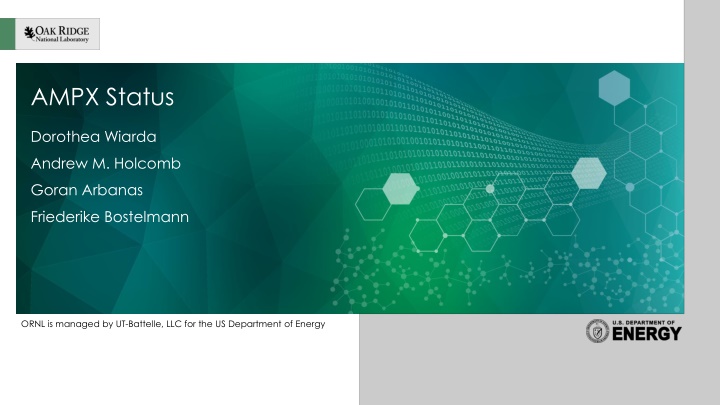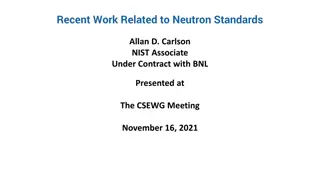
Processing of ENDF/B-VIII.0 Library and Future Plans in Nuclear Data Analysis
Explore the processing of ENDF/B-VIII.0 library within the AMPX framework, along with plans to enhance data sharing with SAMMY 2. Discover the management of ORNL by UT-Battelle, LLC for the US Department of Energy and the upcoming SCALE beta features.
Download Presentation

Please find below an Image/Link to download the presentation.
The content on the website is provided AS IS for your information and personal use only. It may not be sold, licensed, or shared on other websites without obtaining consent from the author. If you encounter any issues during the download, it is possible that the publisher has removed the file from their server.
You are allowed to download the files provided on this website for personal or commercial use, subject to the condition that they are used lawfully. All files are the property of their respective owners.
The content on the website is provided AS IS for your information and personal use only. It may not be sold, licensed, or shared on other websites without obtaining consent from the author.
E N D
Presentation Transcript
AMPX Status Dorothea Wiarda Andrew M. Holcomb Goran Arbanas Friederike Bostelmann ORNL is managed by UT-Battelle, LLC for the US Department of Energy
Overview Processing ENDF/B-VIII.0 AMPX and GNDS Future plans to share code with SAMMY 2
Processing of ENDF-B/VIII.0 library In order to process ENDF-B/VIII.0 an AMPX patch is needed. It will be available in the next SCALE beta. For previous versions the patch is available via email. In order to use the new moderator data in SCALE, a new Standard Composition Library is needed. It will be available in the next SCALE beta. Experimental libraries discussed in this talk will be available in the next SCALE beta. 3
Thermal moderators In SCALE each moderator is bound with a suitable fast reaction and a unique ID. For example: Thermal Zr in ZrH Fast Scale ID 1040090 1040091 90Zr 91Zr Unfortunately there is no easy pattern to: Automatically assign the nuclides to use in the fast region To assign a SCALE ID number. New ID numbers have been assigned and an appropriate configuration file has been written for use in generating inputs for AMPX. 4
ENDF/B-VIII.0 libraries CE library 252 neutron groups with homogenous f-factors. 302 neutron groups for use in fast systems 1597 neutron group library. Covariance library (see Covariance session for more details) Verification and Validation for these libraries is in progress. 5
Some VALID calculations 302g k (252g vs. CE) [pcm] k (302g vs. CE) [pcm] Experiment Measurement CE 252g (new p-tables) HEU-MET-FAST-021-001 1.0000(24) 0.9963(1) 1.0069(1) 1.0006(1) 1067 431 HEU-MET-FAST-040-001 0.9991(11) 1.0045(1) 1.0081(1) 1.0057(1) 362 117 PU-MET-FAST-026-001 1.0000(24) 0.9969(1) 1.0053(1) 1.0005(1) 834 360 IEU-MET-FAST-005-001 1.0000(21) 1.0012(1) 1.0124(1) 1.0054(1) 1127 423 IEU-MET-FAST-006-001 1.0000(23) 0.9961(1) 1.0016(1) 0.9972(1) 549 111 LEU-COMP-THERM-002-004 0.9997(20) 0.9986(1) 0.9986(1) 1.0652(1) -2 6652 LEU-COMP-THERM-002-005 0.9997(20) 0.9974(1) 0.9972(1) 1.0713(1) 16 7402 6
GNDS Access in AMPX The Onion principle at work for GNDS access File access: API for file access, implementation for XML reading using QT XML parser General data containers: Classes for all the general data containers used in GNDS GNDS structure: Classes for GNDS structures (Cross section, Resonance data, etc.) needed by AMPX. These will be expanded as needed. AMPX and SAMMY in-memory structures: Classes that fill AMPX in-memory structures from the classes in the GNDS layer and vice-versa. 7
1-D data including resonance reconstruction Generate a custom template for EXSITE that allows for generation of input files for all incident neutron evaluations Polident Polident (ENDF formatted file) (GNDS formatted file) Compare Compare module makes a comparison of pointwise data on a union grid, but it does not signal missing reactions Compare pointwise X10 X10 (MG with only 1D) (MG with only 1D) Camels module is used to catch missing reactions of grouped data Camels Compare MG results Prude module processes unresolved resonance region (URR) data, whether for shielding only or also for point-wise cross section data Prude Prude (ENDF formatted file) (GNDS formatted file) URR only Compare Compare pointwise 8
Test of covariance neutron data Generate a custom template for EXSITE that allows the user to generate input files for all covariance data Puff_iv module can generate: Puff_iv Puff_iv (ENDF formatted file) (GNDS formatted file) Cross section covariance data from pointwise data (File 31/33) Cross section covariance data from resonance parameter (File 32) Covcomp Compare covariance data Covariance data for CHI (File 35) Each can be selected separately Covcomp module shows differences and missing covariance data 9
AMPX and SAMMY Since many of the same people are involved in AMPX and SAMMY development, we want to make code sharing easy. SAMMY and AMPX/SCALE will still be distributed as different codes, but contain the same code. Internally both codes are still in different source repositories, but shared code will only be contained in one of the repositories. 10
ENDF I/O AMPX already has a C++ ENDF I/O reader and (in many cases) writer API access to the ENDF data is independent of the ENDF file format (ENDF-6 or GNDS) We want to change SAMMY to use the AMPX ENDF API This will include extending the ENDF API as needed. MLBW SLBW and MLBW parameter are stored in the same class with a flag indicating which formalism to use Resonance parameters for Reich-Moore for LRF=3 are initially stored in a different class, but are converted to a LRF=7 class before calculation If derivatives are desired, all formalisms (except URR) are converted to LRF=7 All resonance parameter classes can contain a covariance matrix. If converting to a different formalism, the covariance matrix is re- organized accordingly Reich-Moore LRF=3 ENDF Resonance parameters and Covariance matrix Reich-Moore LRF=7 Adler-Adler URR SLBW only 11
Resonance processing as currently done in AMPX Class describing incident particle and target Implementation for MLBW API to calculated cross section and derivatives at a given energy + some method to determine grid structure New C++ implementation for cross- section and double differential Implementation for Reich-Moore SAMRML for derivatives Implementation for Adler-Adler Note: SAMRML is a simplified version of SAMMY where unneeded features are stripped. 12
Resonance processing as we want to do it Class describing incident particle and target Advantage: One resonance processing code to maintain All new SAMMY features are immediately available in AMPX New ENDF format enhancements and algorithm changes are available in AMPX and SAMMY. API to calculated cross section and derivatives at a given energy + some method to determine grid structure SAMMY 13
Doppler broadening AMPX has an NRC task to modernize Broaden this year, our code to do Doppler broadening. Work on developing a suitable API has started. We plan to connect different algorithms to the API Traditional Solbrig s kernel broadening Leal-Hwang We hope to use the same API and the connected methods in AMPX and SAMMY. 14
Summary New ENDF-B/VIII.0 CE and MG libraries have been produced and tested Work on implementing GNDS reading in AMPX progressed. Currently we are working on kinematic data. We plan more code sharing between AMPX and SAMMY 15






















